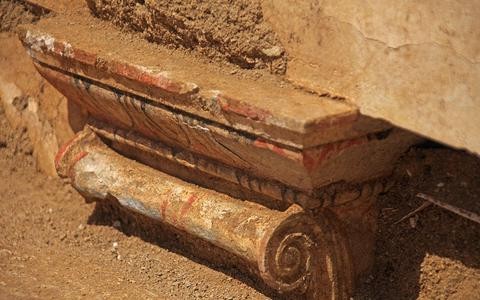Shocking disclosure of the 82 year old looter for illegal excavations in the area of Amfipolis by him and many others. Mr. KE states that he has retired now and he confesses that like many others began to engage in illegal ‘collection’ of valuables from graves, which were then “sold to a dealer and took his share”. “Here everyone is digging …. First the looters as they are called and then the archaeologists,” says the 82 year old who reveals that since 1980 everyone in Amphipoli purchased a metal detector.
“… In Amphipolis i came with my family when I was seven years old” will remember the 82 year old KE, recounting to the ANA-MPA agency how he got in the “kingdom” of (illegal) collection of antiquities which were abounded, not only to the archaeological sites of Amphipoli but to the whole of Greece as well.
Life of Mr. KE could be an exciting novel. Even today in this age his heart is “dancing” when talking about the past and the (illegal) excavation activities.
He dug from Serres up at Mycenae and as he said smiling he dug at Vergina before Manolis Andronikos did…
“The looters as they call them arrive first and then the archaeologists “, he stresses and unravels some aspects of a route which similar lived and live during the night, in the plains and mountains, thousands of his “colleagues” possessed like him from the “gold rush”.
Child impoverished refugee family left with their own, in 1927, Drama and fled to Amphipolis.
“My family came from Drama in 1944. We were farmers. In 1953 I joined the army. There was much poverty in the village … When I got back me and my brother started to remove the shells from the hill. There were many left from the Balkan war. We sold pencils and ‘tountsia’ products in Thessaloniki, at twelve drachmas per kilo. They were easily found because when the bomb would hit, it was leaving traces of smoke on the rocks, it was warm and let smoke. However there were not always holes with fumes. … So we dug . We dug into graves. So it all started “says Mr. KE” and begins unfolding “the memories of the first excavations of grave robbers and their spectacular discoveries.
“Here everyone was digging … The place is semi rocky dug ten inches you could tell if the grave was dug. We were digging especially the Acropolis, opposite the current Archaeological Museum, were the ‘good tombs’, were wealthy.
I personally have opened many tombs : if it was a woman’s tomb, we would normally find gold earrings, necklaces and brooches, and if the tomb belonged to a man we would find some items and rings. Usually it would have been two or three of us and we would go at night.
Then we would sell the findings to the dealer and everyone took their share. The transaction took place in Thessaloniki . If you had found anything, you would call the dealer and let him know.
Statuettes were also found which were sold to the large looters or those who had collections, “remembers the 82 year old and continues”. The archaeologist Dimitris Lazaridis came from Kavala in 1955 and began his archaeological work. (We were the ones to show Lazaridis where the necropolis was) …
Lazarids would walk through the village with a bag and gather all he could by asking everyone to deliver to him whatever they had found, and so I gave myself whatever I had to him.
‘Back then I had found thirty statuettes while I was working on road works, opening the junction in the village and widening the road. Thirty dolls, pigeons “fox” and female face figures I handed over to Lazaridis. I did not receive any payment… One day while a bulldozer was opening the road a marble head appeared. I handed it over as well, but still got no money for it “.
1964-1965: “Following the investigation of the cemetery, I went in search of the city. I attempted a number of tests to the smooth sections of Amphipolis, where the early Christian basilicas were.
My investigations were unsuccessful. However I thought that this would be the most important area of the city and perhaps the market. My conviction was strengthened by the fact that the older villagers called this place Bezesteni, and it was the place that revealed when traversed, remarkable incidental findings such as inscriptions and statues. This town which became part of Athens in the time of Pericles, which means the era of great prosperity of Athens, I’m sure that was a big cosmopolitan city. Among the most distant places were colonies in Amphipolis. And, of course, there were local workshops of jewelry, sculpture, pottery, ” writes in his diary Dimitris Lazaridis”.
“But, however, the most notable building was the one of the early Christian church which was revealed in the Bezesteni position within the field of Joseph Efthimiadi at the east of the disclosed colonnade in the year of 1961 … Within the Community of Amfipolis, behind the house of George Papadopoulos, during the opening of the foundations for building the church of the village, had been found a rectangular trench on the soft rock … so it was observed to be a tomb of the so-called Macedonian Burial but no bones were found “stated Dimitris Lazaridis
to the records of the archaeological Society in 1964, noting that there were archaeological tombs, but empty.
“I went to Mycenae before Andronicus”
“I was from the first ones” confess to ANA-MPA and complement: “I went everywhere, even to Mykines. We would go two to three of us we knew where to look, you could find them by searching. I went to Vergina before Andronicus. They were four of us and went three meters deep when we found a broken shovel, others went before us, “he will say disappointed and added” first to get to the archaeological site will be the antiquarians and then the archaeologists will follow… they can only read the books … “.
“In the area of Ormilia in Halkidiki I got arrested. But I was not really there. It was a conspiracy of the commander of the police security and the Mr. Ik.. along with people of “work”. I paid 1,700,000 drachmas in order me and my brother to stay out of jail and apparantly I was driving a bulldozer. I didn’t even have a diploma … I remember one night back in 1977 we were at the area of Melissourgos in Apolonia, in a village called Pazarouda, that is where we were looking so someone betrayed us and the police came , caught us and took us to Lagadikia.
I was bold, courageous. I said to my brother that I would run away and so I did. At the end we got fifty days jail, paid … Now is a felony, then it was a misdemeanor.
“After 1980, everyone in Amfipolis got detector machines. Thirty people were doing this job, including the police commanders which they were mixed with the Ancient. In 1994 I gave some objects to the archaeological department they estimated an amount, but still not paid me. In 2006 I gave them five bronze and two silver Roman coins, a Byzantine bronze coin, a stathmio and one bronze arrowhead.’s costing about 900 euro, but again they never paid me, says while showing the evidence.
“Now I gave up, I’ve grown old … In the last excavations in Tomb caste, I showed the sergeant of Peristeri the entrance of the Tomb. I gave him a sketch they still have it” he says with obvious pride in his voice and eyes.
At the same time, a few kilometers away from Amphipolis, in the now known Mesolakia, rumors of antiquities give and take.
“There were people in Amphipolis that never worked, they gathered balls and found the coins. You could find coins just while walking. We were farmers, they were searching all day and they were digging all night ” he will tell us and we will continue: “When they started to open graves, people came from all parts, had connections everywhere. They would get arrested, went to court. They will put them through a door and will let them go from another. If we say a lot now we will become wicked “will say the residents of Mesolakias maintaining their anonymity, but without concealing to us that they also find different coins in their fields.
“In the old days we would search with hoes, grab what could find and fled, that is why we found lots of coins and statues in the graves. Nowadays, it’s different. As for the ‘circuit’, it may be closed, but the new learned quickly – from one to another. If the beginning is made then is easy to find you, “says to ANA-MPA, a man from Serres, who has allegedly been involved in the past in case of antiquities, and adds:
“Two years ago, after six months follow-up, they arrested more than 120 people in the North. Greece on charges of antiquities, and caught the ‘brain’ and many are in prison … they were following me as well and even made a search to my house . I did not have nothing but a ‘dirty’ phone within six months, from someone who wanted to sell me some coins. In the antiquities circuit is no way to enter or exit. Amateurs do not exist. When taking a profit from this business , then you’re a professional. ”
He argues that the first looters were the ancient Greeks:
“They buried them in the morning and in the evening they will steal of them. Where there was gold they opened a hole and took it. Some say that the Romans trained monkeys … and monkeys did the job, the picking and then took the takings to a hole. The holes were not made randomly the nine … out of ten in Amphipolis did this job and many died from the fumes. ”
Besides, the associate of Dimitris Lazaridis for 12 years KostasVatitas recalls:
“When we opened a grave with Dimitri Lazaridi the archaeologist removed us in order, as he said, for the grave to get some air. When the large tomb beneath the museum was found Lazaridis told us all to go away in case something bad happens to any of us. They were many of these looters who then died from the fumes. ”
At the same time, in the small café of Mesolakias, the discussion turns from a “public secret” as most of the regulars call it: Double of the Amphipolis inhabitants were the metal detectors you would find at their homes.
What does the diary of the archaeologist Dimitris Lazaridis mentions
04.26.1956, Amphipolis “began systematic excavations at Amphipolis in a large cemetery to protect the area from looting. I made the decision to start, despite weaknesses, to save the amazing number of grave goods. The place was full of pits and sectors of antiquities. ”
This is how the archaeologist Dimitris Lazaridis describes in his diary the need to start excavations at Amphipolis and protect the area from the Archaeological Society, in order to qualify directly then as an archaeological site, putting this way “brake” to looters, who anticipated before him to start the “excavation” and looting whatever they found.
Ask me anything
Explore related questions











